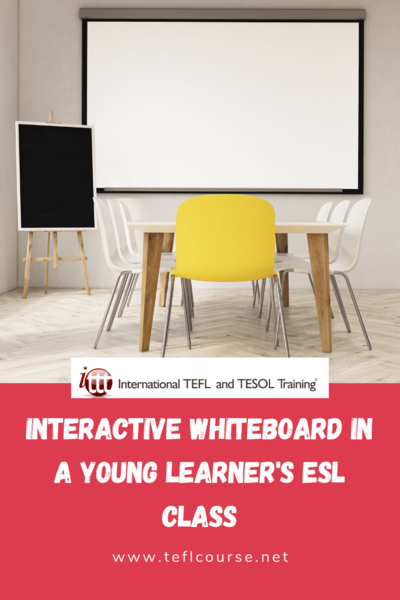Interactive Whiteboard in a Young Learner's ESL Class

Interactive whiteboards have been around since the turn of the millennium. They have been implemented and studied in multiple ESL classrooms, primary schools, and language centers in order to find the best practices. The American Council of the Teaching of Foreign Languages (ACTFL) acknowledges the importance of using technology, such as the interactive whiteboard, to support and enhance classroom-based instructions (Segni & Davidson, 2019). In order for the interactive whiteboard to be used effectively to take advantage of learning opportunities and support children's learning, it is important to use it skillfully in education.
Table of Contents
What is an Interactive White Board?
1. Involving different learning styles
3. Developing learning domains
Do you want to have more opportunities finding a job abroad? Get TEFL certified!
Listen to this blog post:
This post was written by our TEFL certification graduate William N. Please note that this blog post might not necessarily represent the beliefs or opinions of ITTT.
What is an Interactive White Board?
Many classrooms are equipped with an interactive whiteboard as well as a host of other tools of educational technology. An interactive whiteboard consists of a large single-touch or multi-touch screen which is connected to a computer and projector (McManis & Gunnewig, 2012; McClanahan, 2014; Segni & Davidson, 2019). A projector displays the computer's desktop onto the interactive whiteboard. Numerous teachers and researchers have touted the benefits of the interactive whiteboard including the enhancement of multimodality, pace, interaction, engagement, and learning environment (Hockley, 2013; Suparman & Saupi, 2019). On the other hand, some researchers and teachers say that the ineffective use of the interactive whiteboard can lead to it being a distraction or misused. (Bahadur & Oogarah, 2013; Abbasove & Mammadova, 2019). In the end, teachers should see an interactive whiteboard as simply an educational tool and still develop pedagogy.

Also Read: 5 Simple Tips to Improve Your Classroom Management Skills
How to adjust to teaching
The interactive whiteboard cannot replace the teacher in the classroom. Teachers need to have proper training in order to effectively integrate an interactive whiteboard into the instruction of young learners (Hadji-Nikolova & Tasevja, 2018). Moreover, they should be supported by administration and a technical team to help in troubleshooting and training of technical skills (Abunowara, 2016; Segni & Davidson, 2019). Teachers may be required to know the subject matter, produce lesson materials, provide instructions, manage the classroom, and develop the curriculum (Kuo, Yu, & Hsiac, 2013). Moreover, teaching with an interactive whiteboard may require teachers to adapt their lesson plans.
How to Use
One way to use the interactive whiteboard with children is by relying on traditional-teacher-centered classes. Since the interactive whiteboard is usually fixed in the center of the room, teachers have treated the interactive whiteboard as an ordinary screen or whiteboard and presented the study information of the lesson plan through the use of presentational software such as PowerPoint (Hockly, 2013; Teck, 2013). Teachers have also used the interactive whiteboard to teach with the grammar-translation method and drilling because they feared that students were not ready for interaction (Cutrim Schmid & Whye, 2012). Teaching a teacher-centered class seemed to underutilize the features of the interactive whiteboard (Teck, 2013; Segni & Davidson, 2019).
The use the interactive whiteboard should allow for greater student involvement. Students have become more engaged and motivated through the use of the interactive whiteboard allowing them greater success in learning the lessons (Cutrim Schmid & Whyte, 2012; Hadji-Nikolova & Tasevska, 2018). Teachers may like to add pictures, sounds, videos, weblinks, texts, and other combinations to lessons which can be displayed on the board (Bahadur & Oogarah, 2012). Having students contribute and build content can give students more involvement and multimodality to the lesson (Kuo, Yu, & Hsiac, 2013). Interactive whiteboards can enhance students' contribution through practicing vocabulary, playing games, and storytelling.

Also Read: Do I need a TEFL certificate to teach abroad?
Benefits
1. Involving different learning styles
The multimodality of the interactive whiteboard allows the teacher to reach different learning styles. Through the use of multimodality, a student reported that learning with an interactive whiteboard is akin to learning in 3D (Hadji-Nikolova & Tasevka, 2018). Visual learning can be enhanced by the use of the computer to have students manipulate, display, and draw pictures (Abunowara, 2016; Abbasova & Mammadova, 2019). Kinesthetic learning is also enhanced as students interact physically with the board by touching and moving objects on the display (Bahadur & Oogarah, 2013. Teck, 2013). Auditory learning is also enhanced as teachers can add videos, sound effects, and songs. The teacher should not only engage all different learning styles but also be responsive "to the ages and developmental levels of the children, to their individual needs and interests, and to their social and cultural contexts" (McManis & Gunnewig, 2012, p16).
2. Playing games
Teachers can use the interactive whiteboard to have students play games. Using the interactive whiteboard, students enjoyed playing memory games which can be built from templates found on the internet (McCanahan, 2014). Children said that they liked playing games as the lessons became more enjoyable and helped them to learn (Yanez & Coyle, 2010). In virtual reality games, students can encounter and play along with characters which can help them through physical interaction and giving additional instruction or explanation (Sagri, Sofos, & Mouzaki, 2019). Games can be used with all ages.

Also Read: Teaching Vocabulary to Chinese Native Speakers
3. Developing learning domains
The interactive whiteboard provides several ways for teachers to develop student's vocabulary, pronunciation, and grammar skills. First, authentic materials (i.e. menus, weather report, and cartoons) can provide a valuable source of language input for teachers to develop vocabulary and cultural awareness (Abunowara, 2016). Moreover, the interactive equipment encourages students to interact with language in various ways such as not only listening to a word but also seeing a picture or a video of the word (Kuo, Yu, & Hsiac, 2013). Finally, students can work with new words through highlighting, using click-and-drag, and identifying a grammar structure (McCanahan, 2014). The interactive whiteboard seems to allow for enhanced learning of the building blocks to language.
4. Telling stories
Teachers have also used the interactive whiteboard to tell stories to children at various levels. Sagri, Sofos, and Mouzaki (2019) studied how digital storytelling can be used with young learners to help develop their English. In digital storytelling, comics and art can be a good starting point for teachers to introduce grammar, vocabulary, and reading. Moreover, an interactive whiteboard can be equipped with a virtual keyboard which allows students to type letters, words, sentences, and paragraphs to contribute to a whole-class collaborative storytelling activity (McCanahan, 2014). Using predictable storybooks are also helpful in building young learners oral and literary development (Kuo, Yu, & Hsiao, 2013). Reading stories, especially leveled ones, can be used with all age groups and levels.
Do you want to have more opportunities finding a job abroad? Get TEFL certified!
The interactive whiteboard, if used effectively, can enhance the learning of the English language. After receiving proper training and support, teachers can help children become more immersed in the language through activities which are fun and engaging.
Apply now & get certified to teach english abroad!
Speak with an ITTT advisor today to put together your personal plan for teaching English abroad!
Send us an email or call us toll-free at 1-800-490-0531 to speak with an ITTT advisor today.
Related Articles:
- Top 10 Cities in Latin America with the Highest Demand for English Language Teachers
- How to Obtain a Work Visa to Teach English in Mexico
- The 10 Best Destinations for Teaching English Abroad in 2018
- The Best Government Programs For Teaching English Abroad
- Top 7 Spanish Speaking Countries for Teaching English Abroad
- What Scams to Look Out for When Looking for TEFL Jobs




